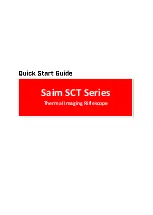
© Opticstar Ltd 2011
10
with a Barlow lens, simply divide the focal length of the eyepiece into the focal
length of the telescope and multiply the result by the Barlow’s magnifying power.
Magnification =
telescope’s focal length / eyepiece’s focal length x Barlow power
For example a telescope with a focal length of 400mm used with an 8mm eyepiece
and x2 Barlow will offer a magnification of x100 (400/8x2=100).
Focal Ratio
The focal ratio represents the
speed
of the telescope’s optics, the focal ratio can be
calculated by dividing the focal length by the telescope’s aperture.
Telescopes with faster/shorter focal ratios like the AR80S benefit from wider fields
of view, and a subsequent increase in brightness and image resolution. Fast f/4-f5
focal ratios are generally best for lower power wide field observing and deep space
imaging. On the other hand slow f/10 focal ratios and above are better suited to
higher power lunar and planetary observation as well as high magnification imaging
in general.
For example when imaging extended deep sky objects like nebulae and galaxies an
f/4 telescope will capture four times the mount of light in the same time period when
compared to a telescope with an f/8 focal ratio. The same does not apply to single
point light sources like stars where aperture alone dictates what you can see.
Field Of View
The field of view is the portion of the sky that is visible through the telescope and
depends on the focal ratio of the telescope. In general higher magnifications result in
smaller fields of view.
Short focal ratios (f/4) with wide fields of view greatly favour deep sky viewing and
imaging, where focal ratios of f/10 and above are better suited for planetary and
Lunar observation. Focal ratios in between these values (f6) may be considered
appropriate for general use.
It is possible to calculate the field of view of a telescope given a certain eyepiece
using the following formula.
Actual Field of View =
Eyepiece Apparent Field of View / Magnification
where
Magnification
= Telescope Focal Length / Eyepiece Focal Length
Consider a telescope with a focal length of 400mm and a 40mm eyepiece with a 70
degrees Apparent Field of View.
Magnification = 400 / 40 = 10
~
Actual Field of View = 70 / 10 = 7 degrees
Содержание AR80S GOLD GUIDE-SCOPE
Страница 1: ......
Страница 2: ...Opticstar Ltd 2011 1...

































